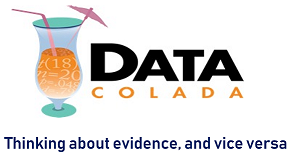The authors of a forthcoming AER article (.pdf), "Methods Matter: P-Hacking and Publication Bias in Causal Analysis in Economics", painstakingly harvested thousands of test results from 25 economics journals to answer an interesting question: Are studies that use some research designs more trustworthy than others? In this post I will explain why I think their…
Author: Uri Simonsohn
[88] The Hot-Hand Artifact for Dummies & Behavioral Scientists
A friend recently asked for my take on the Miller and Sanjurjo's (2018; pdf) debunking of the hot hand fallacy. In that paper, the authors provide a brilliant and surprising observation missed by hundreds of people who had thought about the issue before, including the classic Gilovich, Vallone, & Tverksy (1985 .htm). In this post:…
[80] Interaction Effects Need Interaction Controls
In a recent referee report I argued something I have argued in several reports before: if the effect of interest in a regression is an interaction, the control variables addressing possible confounds should be interactions as well. In this post I explain that argument using as a working example a 2011 QJE paper (.htm) that…
[78c] Bayes Factors in Ten Recent Psych Science Papers
For this post, the third in a series on Bayes factors (.htm), I wanted to get a sense for how Bayes factors were being used with real data from real papers, so I looked at the 10 most recent empirical papers in Psychological Science containing the phrase "Bayes factor" (.zip). After browsing them all, I…
[78b] Hyp-Chart, the Missing Link Between P-values and Bayes Factors
Just two steps are needed to go from computing p-values to computing Bayes factors. This post explains both steps and introduces Hyp-Chart, the missing link we arrive at if we take only the first step. Hyp-Chart is a graph that shows how well the data fit the null vs. every possible alternative hypothesis [1]. Hyp-Chart…
[78a] If you think p-values are problematic, wait until you understand Bayes Factors
Would raising the minimum wage by $4 lead to greater unemployment? Milton, a Chicago economist, has a theory (supply and demand) that says so. Milton believes the causal effect is anywhere between 1% and 10%. After the minimum wage increase of $4, unemployment goes up 1%. Milton feels bad about the unemployed but good about…
[77] Number-Bunching: A New Tool for Forensic Data Analysis
In this post I show how one can analyze the frequency with which values get repeated within a dataset – what I call “number-bunching” – to statistically identify whether the data were likely tampered with. Unlike Benford’s law (.htm), and its generalizations, this approach examines the entire number at once, not only the first or…
[69] Eight things I do to make my open research more findable and understandable
It is now common for researchers to post original materials, data, and/or code behind their published research. That’s obviously great, but open research is often difficult to find and understand. In this post I discuss 8 things I do, in my papers, code, and datafiles, to combat that. Paper 1) Before all method sections, I…
[63] "Many Labs" Overestimated The Importance of Hidden Moderators
Are hidden moderators a thing? Do experiments intended to be identical lead to inexplicably different results? Back in 2014, the "Many Labs" project (htm) reported an ambitious attempt to answer these questions. More than 30 different labs ran the same set of studies and the paper presented the results side-by-side. They did not find any…
[62] Two-lines: The First Valid Test of U-Shaped Relationships
Can you have too many options in the menu, too many talented soccer players in a national team, or too many examples in an opening sentence? Social scientists often hypothesize u-shaped relationships like these, where the effect of x on y starts positive and becomes negative, or starts negative and becomes positive. Researchers rely almost…
